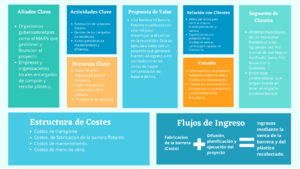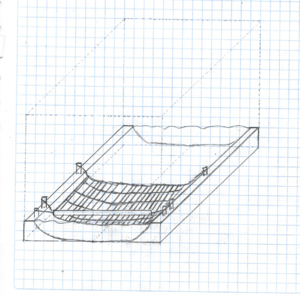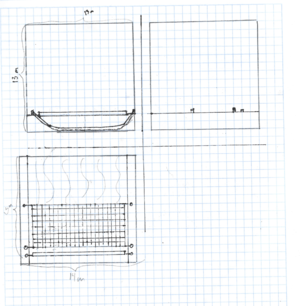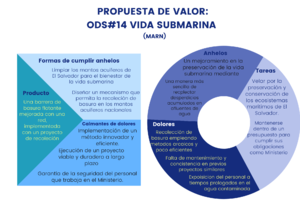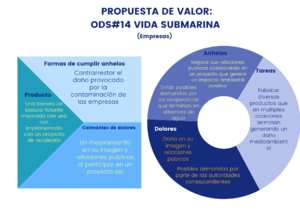Floating trash booms are a sustainable, efficient and cheap way to collect marine debris such as bottles, bags and other materials that pollute the oceans. This project aims to be a solution to garbage collection in bodies of water with large amounts of waste, mostly plastic, that end up in the oceans and threaten aquatic ecosystems, as well as a viable solution for Salvadoran collectors.
Contents
Description
A floating litter barrier is a physical structure designed to capture and contain plastic waste in bodies of water. They can be made from a variety of materials, including plastic, metal, and fabric, and are typically installed in rivers, canals, and oceans where debris accumulates due to currents and winds.
In the country, one of the sectors that can be seen highly benefiting from them are the Río Grande de San Miguel, the Acelhuate River, the Sucio River and the Paz River, all of them with terrible water quality according to the results of the ICA. In these areas, there is a large amount of waste that is dragged towards the sea. In certain areas, organizations such as MARN have placed floating barriers to collect marine debris. Likewise, The Ocean Cleanup map has indicated two points where the most garbage enters the ocean: the Lempa River and Garita Palmera.
On the other hand, these barriers are not maintained by the state, people from nearby communities are the ones who carry out the work of recycling the materials that are detained in the barriers, these people do not receive a salary for their work. work towards the community. This project seeks to make the collection of materials easier for them and provide them with due remuneration for their services.
Problem to solve
Communities have people who, for one reason or another, make a living selecting, separating, cleaning and delivering materials that can be recycled by bottle packaging companies, creation of iron products, packers, etc. This work has very few benefits for collectors, earning between 0.06 - 0.11 cents for each pound of recycling. Added to this is the difficulty of doing it underwater.
Companies that care about the aquatic ecosystems in the area want a practical and efficient solution to contribute to the care and attention of nearby rivers. By introducing floating litter barriers along with proper maintenance and adequate staffing, a concept can be implemented that helps both industries and communities.
Bibliographic review
In this section, a series of projects are compiled, similar to the one proposed, that could be useful for the development of the value proposition, whose focus lies on the Sustainable Development Goal of protection of marine ecosystems. The alternatives were selected taking into account the potential for tropicalization (feasibility), the impact on the communities and combating the problem (effectiveness) and the capacity for improvement (adaptability).
In the following link, you will find each of the investigated projects.
Floating Garbage Barrier/Literature Review
Description of the solution.
Through a review of different projects whose function is to collect marine waste, such as The Great Bubble Barrier, Garbage collectors for streams, Interceptors, etc. As a team, we analyzed its feasibility in the Río Grande de San Miguel, Acelhuate River, Sucio River and Paz River, areas selected to implement the project. We decided to use floating trash barriers as they were easy to implement and relatively low cost.
This project seeks to make the collection of materials easier. This is done through networks connected to the barriers, which capture the debris and with the help of an external force they would be pushed to the surface. Allowing waste to be separated on dry land. On the other hand, it would have a barrier maintenance service along with personnel dedicated to recycling collection.
By creating floating trash barriers with the capacity to transport waste to dry land, fewer people are required to sort and separate bottles and other valuable materials. In addition, it makes the separation process more comfortable by not having to enter the water for long periods of time. The barriers can now be used for longer as they will be more efficient in separating their waste.
Value proposal
A floating garbage barrier modified with a net to maximize efficiency in collecting the large amount of waste in our country's rivers. This barrier will contain all the garbage that passes through the water tributary, concentrating it in one place to facilitate its collection. By placing a net, the waste will be stored there until it is periodically collected so that it can be separated, and then sold to companies dedicated to recycling, so that it can have a new life.
This proposal will be executed together with a project that will generate sources of income for recyclers in the areas with the highest concentration of river garbage, specifically in the municipalities that border the six most polluted rivers in El Salvador. So the people in this area will be invited to take part in training to collaborate in the project, being remunerated fairly for their work.
Competitive advantage
The implementation of floating garbage barriers will act directly in favor of the preservation of the maritime flora and fauna in El Salvador, which is currently extremely contaminated. This project does not represent a considerable expense compared to other more expensive projects, from the manufacture of the barrier to the collection and sale of waste, representing an improvement in the efficiency of waste collection at an affordable price, demonstrating that to have environmental impact it is not necessary to have a very high capital.
Market segments
With this project we seek to reach government organizations, such as the Ministry of Environment and Natural Resources (MARN), because it is responsible for ensuring the preservation and conservation of national ecosystems. At the same time, form alliances with polluting companies that aim to counteract the damage generated by their activities.
Dolores (Pains)
Currently, the MARN has made several attempts to clean and improve the situation of the aquatic ecosystems of our country, however, it has used archaic methods that have not been effective enough. In turn, on many occasions, during contaminated water cleanups, workers are exposed to remaining in contaminated water for very long periods of time, exposing their health and safety. It should also be taken into account that on several occasions due to budget issues or external factors, various cleaning projects have not been able to work in the long term.
Polluting companies have suffered damage to their image and public relations by being responsible for pollution in rivers and lakes that represent water supplies for certain communities. On multiple occasions they have also had to face lawsuits and sanctions from environmental authorities due to this.
Pain Relievers
The floating barrier represents an innovative and effective solution for the problem that MARN seeks to solve, because it considerably maximizes the efficiency in aquifer cleanup campaigns in El Salvador. By having a low cost, it helps them stay within the annual budget assigned to them, at the same time with the network in which the plastic will be stored, it will make it easier for people from the ministry to collaborate in the project, so that they do not have to expose your health and safety.
Companies will be able to offset the damage caused to affected people and communities by supporting the project. In this way, they will improve their image and public relations by participating in a project that has a positive environmental and social impact.
Longings
The MARN aims to preserve and conserve the aquifers of El Salvador. This organization seeks to find effective solutions for the water pollution of our rivers, which flow into the ocean, with the objective that these can be executed while staying within the assigned budget.
Companies seek to improve their image with the environment to achieve a positive and friendly vision, in addition to avoiding possible problems due to the waste that they produce and end up in different bodies of water.
Benefits (Gains)
The Ministry of the Environment will benefit, since the project greatly facilitates the cleaning of Salvadoran rivers and seas, thus ensuring that the contamination rates of aquifers decrease considerably. A factor that will ultimately be favorable is the low cost that the construction of the barriers represents, which in turn will have a significant impact on the populations of each locality, representing income and clean water in their respective area.
The project will help companies reduce the negative environmental effect they produce when providing their services.
Business Model Canvas
Key Allies
Institutions such as the Ministry of the Environment, which is in charge of ensuring the preservation and conservation of maritime ecosystems in our country, will be able to meet their objectives more easily when implementing the project. If we work together with him, we will have easier and more direct access to these municipalities through the support of their respective mayors.
Multiple companies are dedicated to purchasing plastic to be able to recycle it and make new things with it, making a strategic alliance important.
Key resources
The completion of the project will require multiple resources (material and human) that can be observed within the budget. These are essential for project execution to generate efficient results, having a significant impact on national maritime ecosystems.
• Trained workforce for the project: Training will be carried out for the people who collaborate in the project, both for the people of the communities and the volunteers who support the initiative.
• Materials for making the barrier: such as the containers in which they will float, and joined by
• Waste transportation: This must attend each of the areas every 15 days to transport the collected plastic.
Key Activities
Manufacturing of the barrier: In the first instance, a barrier will be manufactured for each area that must be cleaned, with plans to start with the six most polluted rivers in El Salvador.
• Management of collection campaigns: With the help of MARN, and the mayors of each of the departments, a call will be scheduled in each of the areas near the rivers, publicizing the opportunity to participate in the project, The selected people will attend training to then begin the collection.
• Periodic maintenance and efficiency visits: Visits will be made every 15 days to verify the status of the project, the amount of plastic collected and to grant workers their respective remunerations. At the same time, the status of the network will be verified for maintenance.
Income streams
Initially, the project will not make a profit, since the objective is to attract investors and generate the greatest possible impact on the problem of ocean pollution. When the introduction stage has passed, the product is expected to experience growth and subsequent maturity, these two points being where profits will be perceived.
Therefore, at the beginning the income from the sale of the barrier and the waste collected will be equal to the costs. This last category includes the raw materials for manufacturing, the salary of the material collectors, the transportation of garbage and the network, administrative expenses, tax obligations and legal expenses. If profits are obtained, they will be retained for the improvement of operations and the scope of the program.
Customer segments
As a product that requires constant maintenance and cleaning, the barrier is designed to be purchased by government and civil organizations. Therefore, potential clients include the municipal mayors of the municipalities where the most polluted rivers in El Salvador are located, such as the Río Grande and the Lempa. Likewise, the central administration is taken into account due to its influence and resources to combat ocean pollution.
However, the project also considers associations, such as ADESCOS, and non-governmental organizations, similar to Salvanatura. These actors are also very useful when deploying the barriers, since, in addition to fully or partially covering their cost, they can provide volunteers. On the other hand, the last segment, which is also part of the private sector, are those companies interested in reducing their environmental impact or acquiring plastics. For example, Ternova and Banco Hipotecario have the capacity to finance the implementation of the system on a larger scale, which would allow them to improve their corporate image and work for the progress of the communities.
Relationship with clients
The creators of the project will maintain contact with clients and consumers through different activities:
· Periodic visits to facilities and client offices, to discuss and verify the operation of the barrier. With this, not only will investors be held accountable, but aspects related to resources and budgets will also be clarified.
· Training for local populations and volunteers to provide the knowledge and tools necessary to manage barriers and manipulate waste, developing the project effectively and efficiently.
Channels
Through the following means, the project will be disseminated with the civilian population and other actors.
· Call to the population through social networks, such as Instagram and Tiktok, and media, which include the Tele Corporación Salvadoreña channels.
· Talks at universities and schools to raise awareness about the importance of protecting the ocean and encourage students to participate as volunteers. These can also be carried out in churches, clubs and other civil associations.
Budget
A budget table was created to estimate the cost of implementing our project by area. These prices may be subject to change depending on the size of the area, the amount of waste accumulated and the labor that would be made available. In conclusion, we present an estimate of the total cost of the project and should be used as a reference only.
The following is a list of materials that are expected to be used to carry out the project.
| Item | Amount | Cost per unit | Total |
|---|---|---|---|
| ABN Multi-Purpose Heavy Duty Cargo Net with Nylon Hooks; 72", 96" — Nets that facilitate the collection of material obstructed by MARN barriers | 6 | US$20.99 | US$125.94 |
| Transportation of the collected material to the nearest recycling centers — You can count on different collection trucks such as Carroceria el Buen Amigo in the eastern rivers and others... | 1 | USD 150.00 | USD 150.00 |
| People who receive payment for collecting materials — On collection day, people in the area who help collecting and separating the different materials would be paid a little more than the minimum daily wage. | 5 | USD50.00 | USD 250.00 |
| Reusable plastic bottles — The bottles would go inside a container to make it float. | twenty | USD 0.30 | US$6.00 |
| Pyta Nylon - To tie the structure | 1 | US$2.50 | US$2.50 |
| grand total | US$534.44EUR 459.24 <br />GBP 389.82 <br />CAD 662.16 <br />MXN 11,133.90 <br />INR 39,969.90 <br /> | ||
Goal: (1 budget table)
Conclusions and recommendations
The Floating Garbage Barrier is an innovative project that seeks to address the serious problem of pollution of oceans and seas due to plastic waste. This device has been designed with the objective of capturing, effectively and with available resources, floating garbage in rivers and preventing it from reaching the sea, thus reducing the amount of waste that contaminates aquatic ecosystems. The implementation of this type of technology is essential to protect marine biodiversity and improve the quality of life not only of coastal communities, but also of humans in general, whose food chain is threatened. For the correct implementation of the project, the progress of the inhabitants of the affected areas must be taken into account.
Final presentation
Below you will find a link that will guide you to a short video presenting our project:
Delivery recommendations
- You can make your diagrams in Miro, export to image and upload to Appropedia through the following page: Special:UploadWizard .
References
Claudia, C. (2021, March 1). Recycling in El Salvador: work for some, profits for others - Different Latitudes . Different Latitudes. https://distintaslatitudes.net/indispensables-pero-invisibles/reciclaje-el-salvador
National Hydrological Service. (2003, September 14). EVALUATION OF THE WATER QUALITY OF THE RIO GRANDE DE SAN MIGUEL YEAR 2003. MARN. http://www.snet.gob.sv/Hidrologia/icasanmiguel.pdf
The Ocean Cleanup. (2022, April 13). River Plastic Pollution Sources • The Ocean Cleanup. https://theoceancleanup.com/sources/
